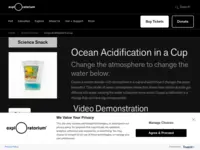Ocean Acidification in a Cup
https://www.exploratorium.edu/snacks/ocean-acidification-in-cup
https://www.exploratorium.edu/snacks/ocean-acidification-in-cup
Exploratorium
This model of ocean-atmosphere interaction shows how carbon dioxide gas diffuses into water, causing the water to become more acidic. The video demonstration and instruction provide an explanation of the chemistry behind this change and the consequences of ocean acidification. The video also addresses a misconception about how ocean acidification affects shelled organisms.
This learning activity takes 30 minutes.
Learn more about Teaching Climate Literacy and Energy Awareness»Grade Level
Topics
Climate Literacy
This Short Demonstration/Experiment builds on the following concepts of Climate Literacy.
Click a topic below for supporting information, teaching ideas, and sample activities.
Notes From Our Reviewers
The CLEAN collection is hand-picked and rigorously reviewed for scientific accuracy and classroom effectiveness.
Read what our review team had to say about this resource below or learn more about
how CLEAN reviews teaching materials
Teaching Tips | Science | Pedagogy |
Technical Details
Teaching Tips
- The instructions for this experiment provide alternatives for lab equipment and materials that might be unavailable, such as a substitute for the acid indicator bromothymol blue.
About the Content
- This classroom experiment allows students to see the process of ocean acidification in action. It creates a carbon-dioxide rich atmosphere above a layer of water with a pH indicator in a cup. The carbon dioxide diffuses into the water and eventually raises the pH, which can be seen with the pH indicator. The website describes the processes of ocean acidification, the fast carbon cycle, and how these processes affect sea life.
- Comments from expert scientist:
Scientific strengths: Easy to do, though the required supply of bromothymol blue might be difficult in some schools (thinking of schools without a chemistry shop).
Suggestions: None.
About the Pedagogy
- This is a controlled experiment that can be completed in a typical classroom laboratory setting. Students will create a model of an ocean-atmosphere interaction that shows how carbon dioxide gas diffuses into water, and compare it with a control.
- Before conducting the experiment, students should understand how an acid indicator works and the fact that mixing vinegar and baking soda creates CO2 gas.
- This classroom experiment can be done as a demonstration or a lab activity.
- The website provides explanations, references, and discussion questions, and teaching tips.








